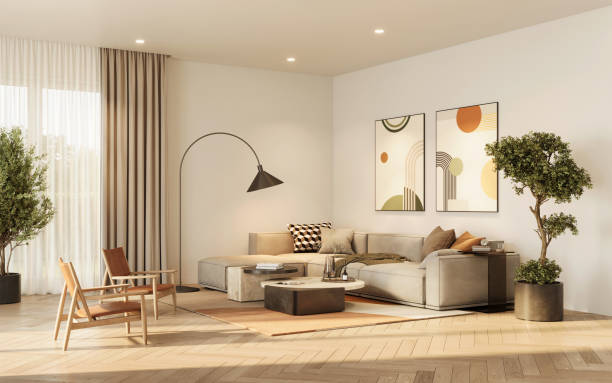Homes across Singapore shift toward clean and simple looks. Yet even the sleekest room needs a burst of colour to feel alive. That’s where accent colours step in. These colours lift a space, give it character, and help certain spots stand out. When you apply accent colours with care, your home feels fresh and balanced. This guide explains how to choose them, where to use them, and how they make your residential interior design more exciting.
What Is an Accent Colour?
An accent colour is a bold or bright colour that shows up in small parts of a room. You might splash it across a cushion, a chair, a small wall, or even part of a shelf. Accent colours don’t cover the whole room — they just add life to it.
Good accent colours don’t shout. They speak gently but clearly. They help your eyes notice special parts of the room. Designers use accent colours to tell stories in homes.
Why Contrast Feels Right in Modern Homes?
Most homes today use soft tones — white, grey, or cream. These colours feel calm and quiet. But sometimes they also feel plain. Accent colours bring energy to these calm spaces.
Accent colours do three helpful things:
- They break up dull spaces and add fun.
- They guide your eyes to important corners.
- They split big rooms into smaller, easier zones.
When a residential architect Singapore homeowners trust works on a new home, they often plan these colours early. That way, the colour feels part of the space, not added later as an afterthought.
How to Pick the Right Accent Colour?
You don’t need to know fancy colour names to pick the right one. Just ask yourself three simple questions:
1. Do I want this room to feel calm, happy, or bold?
2. What colours already live in this room?
3. What kind of light shines here during the day?
- Cool Colours for Calm
If you want a peaceful feel, try blue, green, or greyish shades. These colours work well in bedrooms and study corners.
- Warm Colours for Cheer
For lively places like kitchens and living rooms, use yellow, orange, or red tones. These colours spark movement and warmth.
- Bold Colours for Style
Deep purple, strong teal, or even black can give your space a sharp and stylish edge. Use these sparingly — too much can feel heavy.
How Light Changes Colour?
Light changes how a colour looks. A bright red wall in daylight might turn rusty in the evening. That’s why you should test your colours before painting a full wall.
Smaller homes or flats may feel tight with heavy accent shades. If your room feels small already, use soft colours in small patches.
Favourite Colour Combos in Singapore Homes
People in Singapore love colours that feel cool, natural, or tropical. Here are three popular pairs that work well:
- Grey and mustard yellow – warm and sharp at once
- Olive green and soft beige – grounded, calm, and stylish
- Turquoise and off-white – fresh and bright
Some homeowners also choose colours that show their culture — like red or gold — but still match a clean, modern feel.
Accent Colour Ideas Based on Wall Colours
Before you choose, take a look at this table. It shows how different accent colours team up with common wall colours.
| Wall Colour | Good Accent Colours | Feeling Created |
| White | Navy, coral, moss | Clean and bold |
| Light grey | Mustard, teal, wine | Warm and neat |
| Cream or taupe | Forest green, rust | Natural and deep |
| Soft beige | Indigo, blush | Simple and pretty |
| Pale blue | Ochre, deep pink | Bright and cheerful |
You don’t need to follow this table strictly. It’s just a helpful start.
Where to Use Accent Colours?
You don’t need to paint a whole wall or buy all-new furniture. Start small. Here are smart spots to use accent colours:
1. One Wall
- Paint one wall in a room a different colour. This gives focus without feeling too loud.
2. Pillows and Rugs
- Pillows and rugs are easy to switch when you want to change. They also bring warmth and colour to plain floors or sofas.
3. Shelves and Cabinets
- You can paint the back of a shelf or part of a cabinet. It’s a surprise that makes people smile.
4. Lights and Handles
- Choose bold light covers or door handles. These tiny items often stand out more than big furniture.
In residential interior design, such small details show that every choice has a purpose.
Mistakes to Avoid
Many people love colour. But too many colours can confuse the eyes. Here are a few things to avoid:
- Don’t pick more than two accent colours for one room.
- Don’t forget to check how your colours look in both sunlight and lamp light.
- Don’t place strong colours in every corner. Keep some spaces quiet.
Let your accent colour sing, not shout.
How Architects Use Colour?
If you’re building or remodelling, an expert can help. A residential architect Singapore locals work with will suggest colours that suit your home’s shape, size, and light.
They also look at things like flooring, wall texture, and ceiling height. Accent colours work best when they match these details. Architects don’t just make your home look pretty — they shape how it feels to live in.
Rooms and Colours: What Works Where?
Each room has its job. Your accent colour should help that room do its job better.
1. Living Room
- Try warm, welcoming shades like orange, maroon, or rich brown.
2. Bedroom
- Use calm colours like soft blue, lilac, or sage green to help your body and brain rest.
3. Kitchen
- Go for happy tones like yellow or light green to make the space feel fresh.
4. Study
- Stick to deep, quiet shades like navy, grey, or bottle green to help you focus.
Accent colours help rooms speak without using words.
Trends for 2025 and Beyond
Trends change, but smart colour use never goes out of style. Right now, people like earthy colours — think clay, leaf, and sea tones. These match well with Singapore’s nature and weather.
Still, classic colours like navy, forest green, and terracotta stay popular. They blend with many styles and don’t go out of fashion quickly.
Final Thoughts
Colour does more than decorate — it helps us feel, rest, and connect. Accent colours, when chosen well, make a space feel truly yours. They pull attention to what matters, brighten up what feels dull, and remind us that design can be fun.
With help from tools, guides, or a trusted residential architect Singapore, you don’t need to guess. Start with small touches. Watch how they shift your space. Then grow from there.
Modern interior design accent colours Singapore homeowners love usually come from care, not luck. When you trust your taste, test new things, and listen to how your home feels, you’ll build a space that feels just right — colourful in all the right places.
FAQ’s
1. What are accent colours in interior design?
Accent colours are secondary shades that highlight or contrast with the main colours in a room. They bring energy, balance, and visual interest without overpowering the space.
2. Why are accent colours important in modern Singapore homes?
Modern interiors in Singapore often feature neutral bases like white, grey, or beige. Accent colours add personality, create contrast, and make rooms feel more lively and welcoming.
3. Which accent colours work best with neutral palettes?
Bold tones like navy blue, emerald green, or mustard yellow pair beautifully with neutral walls. Softer shades like blush pink or sage green also work well for a calmer mood.
4. How many accent colours should I use in one room?
Most designers recommend one or two accent colours. Using too many can feel busy, while a few strong choices create balance and focus.



